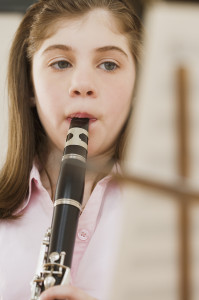When I first started to teach music lessons, I was shocked at how much I learned. I found that the true test of whether I really understood what I was doing as a performer was when I tried to teach it to someone else. Since then, my understanding of this observation is one of the most important insights I have gained that positively influences everything I do in life. Artists who make a commitment to teach others learn that the more they are able to communicate successfully, the more they know themselves and the more consequential their art. As they teach their art form, they use the self-reflective aspects of their arts experiences to become effective communicators, good listeners and excellent observers. These are tools that are important to use in everything we do, whether interacting with a friend, a coworker, or a child—at home, at work, or at the grocery store.
How do you know if you’re successful as a communicator, listener, or observer?
 I once asked a gifted high school clarinetist to consider taking private lessons from one of the people on a list of teachers in the area. She hung her head and said in a shy, soft voice that she didn’t want to because she had tried that once, but the teacher kept telling her to look at her embouchure in the mirror; she went on to explain that she didn’t know where to look because she didn’t know what her embouchure was! If you’re not familiar with the particulars of wind playing, the embouchure is the position and use of the lips, tongue, and teeth in playing. Even if she had known where to look, she wouldn’t have known what to do with it. This teacher truly cared about the progress of the student but wasn’t communicating exactly how to accomplish what he knew would improve her playing and wasn’t fully aware of her dilemma. They had both made some incorrect assumptions.
I once asked a gifted high school clarinetist to consider taking private lessons from one of the people on a list of teachers in the area. She hung her head and said in a shy, soft voice that she didn’t want to because she had tried that once, but the teacher kept telling her to look at her embouchure in the mirror; she went on to explain that she didn’t know where to look because she didn’t know what her embouchure was! If you’re not familiar with the particulars of wind playing, the embouchure is the position and use of the lips, tongue, and teeth in playing. Even if she had known where to look, she wouldn’t have known what to do with it. This teacher truly cared about the progress of the student but wasn’t communicating exactly how to accomplish what he knew would improve her playing and wasn’t fully aware of her dilemma. They had both made some incorrect assumptions.
- The teacher assumed the student knew what the word embouchure meant.
- Since she was looking in the mirror, he assumed she was trying to do what he asked.
- He assumed she simply wasn’t capable of doing what he was asking.
- The student assumed she would appear ignorant or disrespectful if she asked what it was she was looking for in the mirror.
Situations like this are frustrating for both the teacher and the student. The teacher may think the student isn’t able or isn’t trying; the student wants to do what the teacher suggests, but she doesn’t know how to accomplish it, and in this case she was too embarrassed to ask.
Once the problem was brought to his attention, the teacher was able to adapt quickly by connecting to the same commitment and self-reflection he used as a performer. Read more…
Sign-up for the Arts Awareness eNewsletter and receive a free gift “Three Lessons to Begin to Make Artistic Principles Work for You in Fascinating Ways.”
